I may receive a commission if you purchase through links in this post. I am not a doctor; please consult your practitioner before changing your supplement or healthcare regimen.
You’ll love making homemade Ginger Tincture. This easy natural remedy is a wonderful way to support digestion, but also great for several other ailments. Just 2 ingredients and a jar is all you’ll need!
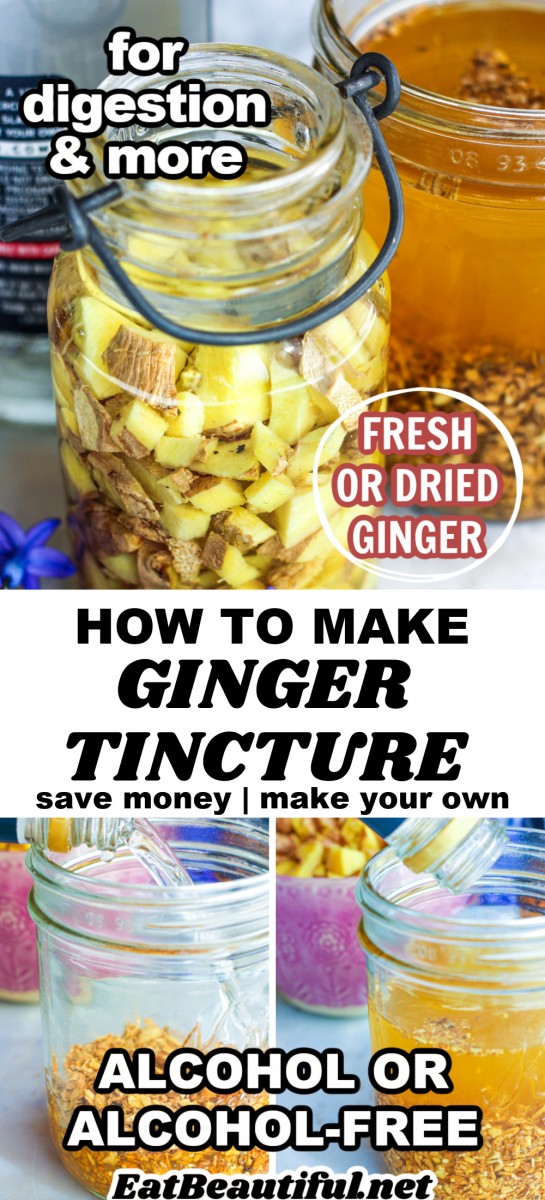
Ginger Tincture is ideal to keep on hand — a DIY natural medicine-cabinet staple.
The main tincture recipe below is made with high-proof alcohol. But I also give two variations for those of you who need alcohol-free. One is made with apple cider vinegar, and the other with vegetable glycerin. See the Notes section below the recipe for these.
Benefits of Ginger Tincture
- aids digestion (stomach ache, gas, bloating, overeating, food poisoning)
- cleanses liver
- aids immune system
- relieves nausea (including pregnancy-related)
- reduces motion sickness
- helps fight viruses
- clears congestion
- increases circulation
- reduces fever and chills
- relieves menstrual pain
- alleviates headaches
See below the recipe for more specific health benefits.

How to use Ginger Tincture medicinally
Most tincture remedies are simply taken in a little water. To do this with Ginger, you may use just a little water, an ounce or two. And then add the amount of Ginger Tincture you want.
But you may also use a full glass of water for higher doses, that are spicy. This is quite delicious.
Unlike many tinctures, the dosage of Ginger can be low. As the flavor indicates, a little goes a long way.
You may need just a few drops. If serving in a large glass of water, you may use more, up to half a teaspoon. It will be spicy!
For most adults, 1/4 teaspoon is a good place to start, to see what you like and how it works for you. Stir into 6 or 8 ounces of water.
Let me know in the comments below how you like it. I find it works very fast!
Remember: Ginger Tincture is wonderful for occasional medicinal use, but if you have chronic discomfort, seek the help of your doctor.
Warning: While completely safe for most people, those on prescription medications (especially blood thinners), please check with your practitioner before treating your symptoms with any herbal remedy.
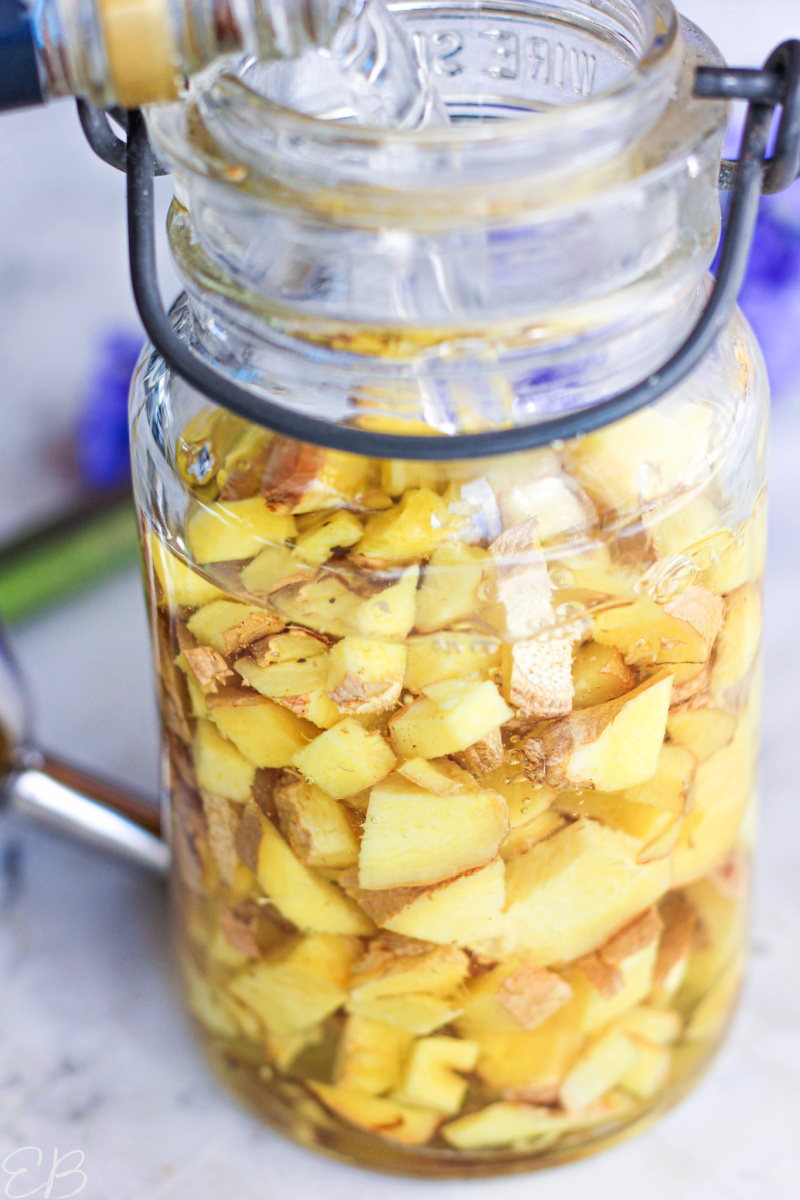
How to use Ginger Tincture for culinary purposes
Yes, you can also make delicious drinks and dishes with Ginger Tincture!
Here are some fun ideas, that will also aid digestion:
- Add to your favorite juices or smoothies. Start with 1/8 to 1/4 of a teaspoon per serving; then add more to taste.
- Use in bubbly water. Sweeten if desired.
- Make ice cream; add 1/2 a teaspoon, or more to taste, to create Ginger Ice Cream. Also try it in this flavor.
- Liven up broths and soups, to taste.
- Stir into yogurt, applesauce or porridge with a little sweetener.
- Add to warm or hot water with fresh lemon juice and/or raw honey. Garlic may also be added.
Ingredients in Ginger Tincture
You’ll need just two ingredients to make homemade Ginger Tincture:
- fresh or dried ginger root (This one‘s great.)
- high proof alcohol (I use 80-100 proof vodka.)
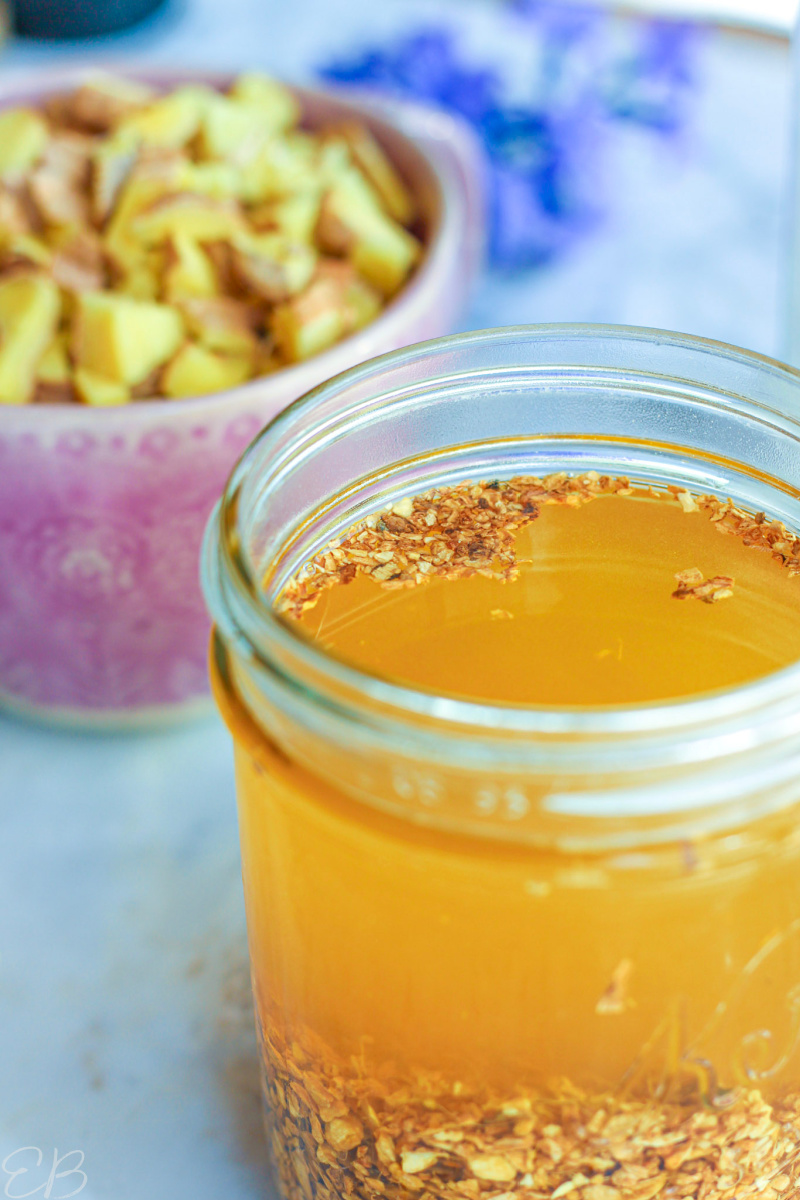
How to Make Ginger Tincture
To use dried ginger: Fill any size jar you prefer 1/3 full with chopped dried ginger root. Pour alcohol over the root up to the neck of the jar. Screw on your lid tightly. Shake a few times. Place in cool, dark location (I use a kitchen cupboard) for 4 to 6 weeks. Every other day or so, or as little as once a week if you forget, shake the bottle. After 6 weeks, strain and store. Ginger Tincture lasts several years.
To use fresh ginger root: Fill jar of choice 1/2 full of chopped fresh ginger root. (It does not need to be peeled first.) Pour alcohol over the root up to the neck of the jar. Screw on your lid tightly. Shake a few times. Place in cool, dark location (I use a kitchen cupboard) for 3 to 4 weeks. Every other day or so, or as little as once a week if you forget, shake the bottle. After 4 weeks, strain and store. Ginger Tincture lasts several years.

My favorite way to use Ginger Tincture
Hands down, I use Ginger Tincture the most often to aid digestion!
If someone in the family comes to me with a stomach ache, Ginger Tincture is an effective and gentle remedy. If that stomach ache is related to digestion or a virus, Ginger Tincture is a great option.
However, Ginger Tincture is also my easy go-to for headaches.
How fast and well it works for both ailments is astonishing!
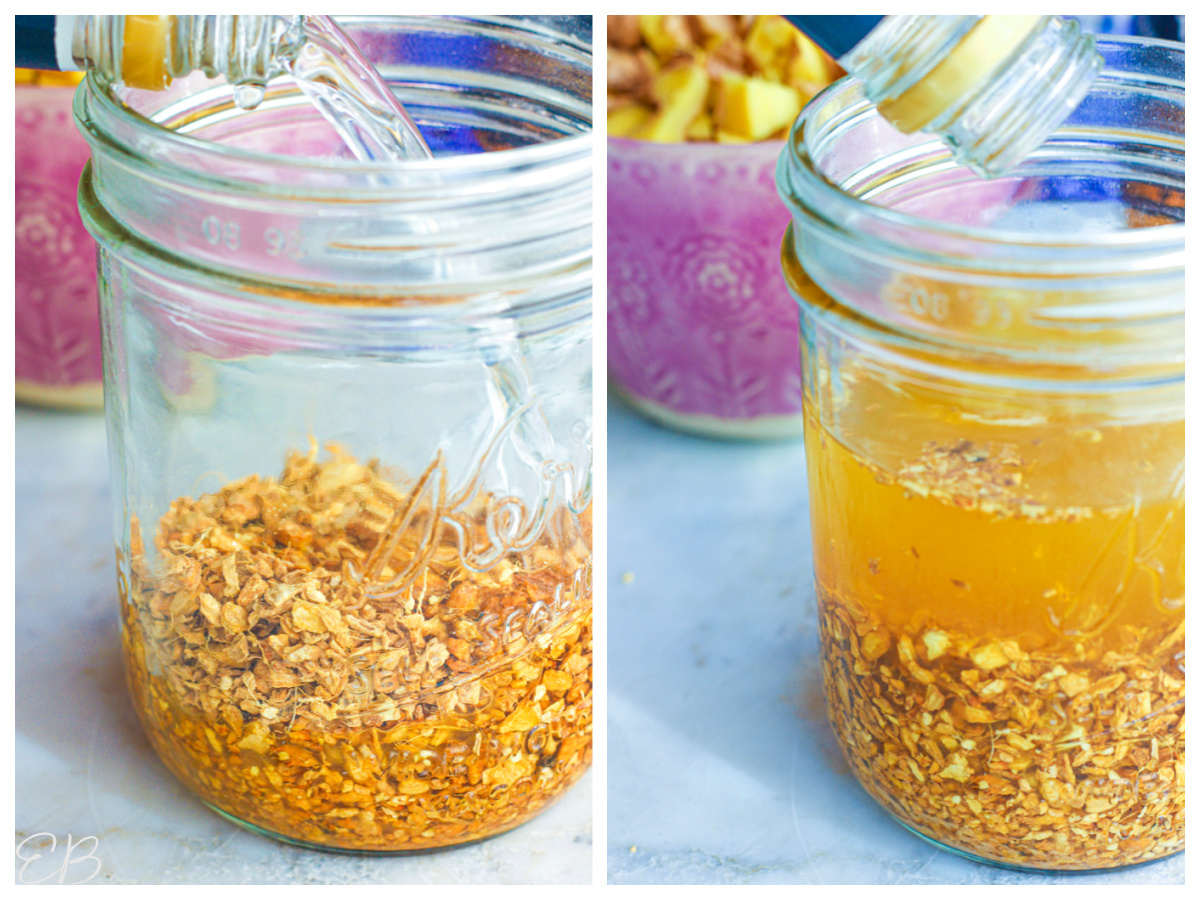
How to store Ginger Tincture
You may use traditional tincture bottles. (Find them here.)
Pro Tip: To pour a large jar of freshly made Ginger Tincture into a small bottle with dropper, use a stainless steel funnel. (Find the right size funnel here.)
First pour the tincture through a fine mesh sieve, into a larger dish with a pour spout.
You may also like these tincture bottles that come with small funnels.
Lastly, Ginger Tincture is the one tincture I make that I don’t always transfer to a smaller container. Sometimes, I just keep the original jar with ginger in the cupboard and use a measuring spoon to scoop out a small bit, which I stir into water. Works great if you plan to use up the tincture pretty quickly.
For long term storage, transfer strained tincture into storage bottles.
Other ideas for Ginger Tincture
Unlike many herbal tinctures, which are quite personal to one’s unique health, Ginger Tincture is gentle and ideal for almost everyone.
The fact that it also tastes amazing means: Ginger Tincture makes a great gift!
If you end up buying a lot of high-quality tincture bottles (like these), set aside several of them for gifts. Attach a little tag or card, or tell your loved one how to use their new herbal tincture for health and in the kitchen! {Refer to those sections above^^.}
Find sticker labels for your bottles here.
Final benefit: save money making your own
The final benefit worth noting about making your own tinctures is the money you’ll save. One 4-ounce bottle of Ginger Tincture costs $40 or more.
Ginger root is quite inexpensive, and I know you’ll love the easy process of making your own.
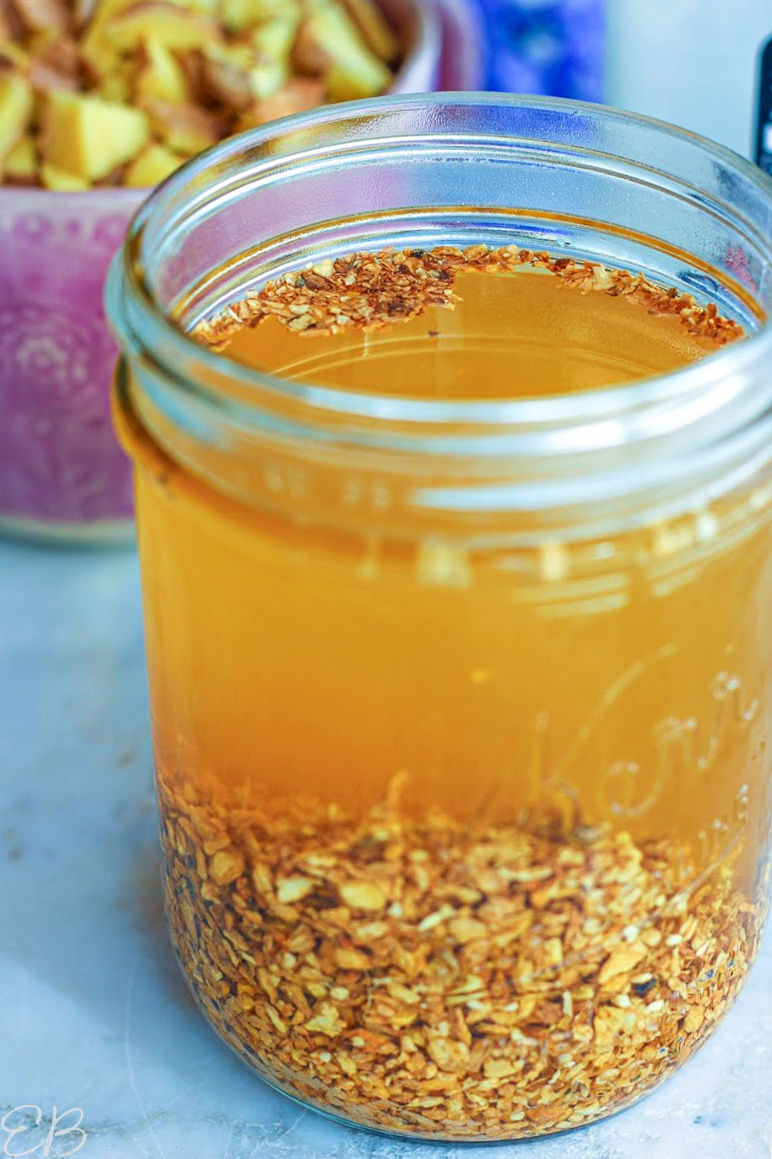
How to Make Ginger Tincture
Equipment
- jar with lid
Ingredients
To make 2 cups Ginger Tincture, follow the recipe amounts below, but you may make any amount you like by skipping to the Instructions and using the jar size to dictate how much you make). No exact measuring is needed.
- scant 2 cups 80 to 100 proof vodka or other high proof alcohol like brandy
- ½ to ¾ cup ginger root dried or fresh, chopped (See more about the amount of ginger to use based on jar size in the Instructions below.)
Instructions
- To use dried ginger: Fill any size sterile jar ⅓ full with chopped dried ginger root. Pour alcohol over the root up to the neck of the jar. Screw on lid tightly. Shake a few times. Place in cool, dark location (I use a kitchen cupboard) for 4 to 6 weeks. Every other day or so, or as little as once a week if you forget, shake the bottle. After 6 weeks, strain and store. Ginger Tincture lasts several years.

- To use fresh ginger root: Fill sterile jar of choice ½ full of chopped fresh ginger root. (It does not need to be peeled first.) Pour alcohol over the root up to the neck of the jar. Screw on lid tightly. Shake a few times. Place in cool, dark location (I use a kitchen cupboard) for 3 to 4 weeks. Every other day or so, or as little as once a week if you forget, shake the bottle. After 4 weeks, strain and store. Ginger Tincture lasts several years.

Notes
Turmeric variation —
To make 2 cups Ginger-Turmeric Tincture, use the fresh ginger version of the recipe above. Then:- substitute ¼ of the overall ginger with chopped fresh turmeric
- add 2 teaspoons black peppercorns.
Alcohol-free variations —
If you do not wish to use alcohol to make your tincture, replace it with:- apple cider vinegar
- or vegetable glycerin (Find a sustainable brand here.)
- Follow the recipe above for the same ratio of root to liquid. Fill the jars accordingly.
- Screw the lids on tightly.
- If using apple cider vinegar, you are done. Set aside your jar(s) as outlined in the main recipe above.
- If using glycerin, place filled jars in a slow cooker (or a pressure cooker [like the Instant Pot] with slow cooker feature) that's lined with a towel and filled with water. Slow cook on low heat for 3 days.
- Remove and strain. To strain, you may need to use your hands to squeeze out any extra glycerin.
- Use a funnel, to transfer strained tincture to little bottles with droppers.
- Store glycerin-based tinctures in the fridge, if possible.
Nutrition

More about what alcohol is best for tinctures
Vodka is the best choice for most people, because it’s affordable and meets the requirements: it has to be at least 80-proof (namely, 40 percent alcohol) to prevent any fungal growth of the plant material in the bottle.
Brandy may also be used, but it’s often more expensive.
100-proof alcohol (50 percent alcohol) is the very best choice, if you can find it.
Some other considerations when choosing your alcohol:
- Do you need gluten-free? If so, be sure to buy pure, gluten-free vodka.
- Look for the best low cost option you can find.
- I always buy alcohol in glass bottles. Avoid plastic bottles.
More specific health benefits
Ginger is effective against invasive bacteria in the intestinal tract: Helicobacter pylorim, Salmonella typhimurium, Escherichia coli, Vibrio cholerae and Pseudomonas aeruginosa.
It may also be used on the skin and to affect soft tissues: for Staphylococcus aureus and in the respiratory tract for Streptococcus pyogenes, Streptococcus pneumoniae and Haemophilus influenzae.
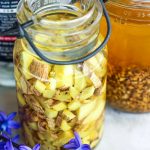
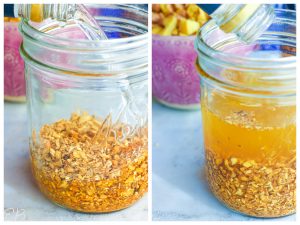
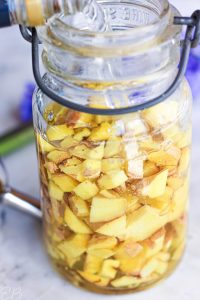

Alex says
Hi Megan,
I am looking forward to making this tincture with apple cider vinegar and dried ginger – two things I can actually consume right now. 🙂 I have a couple of questions, though.
1. Does dried ginger include powdered ginger, as in the powdered spices I buy at the grocery store? Would using powdered ginger change the recipe and ratios?
2. Just curious about the tincture being made only with dried ginger if the base is apple cider vinegar. Why not use fresh ginger?
Thanks for posting this!
Megan says
Hi Alex, great. 1) No, powdered ginger does not work as well in this recipe. It can be done but is another can of worms (Clumping, different ratios, almost never done by herbalists, lots of straining afterwards through fine cheesecloth, but can be done!, if you’d like to try that method.) 2) If you use fresh ginger with apple cider vinegar, you’ll need to apply steady warmth and an aerobic environment. Instead of creating a tincture, you’ll be creating a ferment. This can be done. You’ll basically follow the steps for making homemade apple cider vinegar with fresh ginger in it. So, a different process and outcome. Good questions. I hope that helps!
Naomi says
Hi Megan, I’m super excited about my ginger tincture. I started it several days ago, after ordering the Starwest chopped dried ginger. My concern is that after just a few days the ginger has swelled up and pretty much filled the jar almost to the top, leaving very little liquid in the jar. I used 1/4 cup of the ginger in a pint jar, filling to the top, even a bit past the shoulder of the jar. Should I transfer to a larger jar and add more vodka? I question if there’s even a half cup of liquid in there right now.
Megan says
Hi Naomi, yes! That will be an easy solution. Choose a jar twice the size, and add more vodka, as you said. I haven’t had mine volumize to that degree, but yours will be good and fine. It may be that that batch was dehydrated more, hard to say. I’m glad you’re excited about it! It’s definitely a rewarding experience and then item to have on hand! 🙂
Rebecca says
I tried this and found it doesn’t taste all that gingery?? I used fresh ginger, cut up as your directions say, in a big jar half full, then poured vodka (and a little bit of just alcool- plain alcohol) to the rim. Both 40 % alcohol, which, when I looked this up, said it equals 80 proof. I left it for 4 weeks, shaking/moving it around every couple of days. All I really taste is alcohol. Any ideas why? I was so hoping for a strong ginger taste. It makes me wonder if I’m even getting the benefits of a ginger tincture.
Megan says
Hi Rebecca, great questions. By plain alcohol, I assume you mean it has little water in it, like Everclear. If so, it is up to 190 proof. Sadly, this may actually cheat you out of the more water-soluble constituents in some plants, including fresh ginger. The highest number of chemicals will be extracted at 80-100 proof. When in doubt, vodka is always the best option. You might try adding more ginger AND glycerin or distilled water to your tincture to salvage it, and keep it going another 4 weeks or so. You wouldn’t need to remove the original ginger; it is well-preserved. This paper may help you determine how much water to use based on the size of your jar and the amount of plain alcohol you used: http://7song.com/wp-content/uploads/2018/01/Herbal-Pharmacy-Tincture-Ratios.pdf
Rebecca says
Thanks for the response. Now I have another question. I already took out my ginger but I froze it to use for smoothies. Can I put it back with the alcohol at this point? And the plain alcohol (Alcool it’s called) I used was also 40% alcohol like the vodka, and I didn’t need much, just enough to top up the bottle to the rim. Thanks again!
Megan says
Hi Rebecca, no, I wouldn’t use that ginger again. I’m not sure what went wrong with yours based on the Alcool you used.
Hélène says
If u leave the ginger in the jar and just start scooping out tincture in 6 weeks, can u refill with more vodka when say, the jar gets down to half full? Or wouldn’t the dose be accurate anymore? Would the ginger be “spent” in the first tincturing?
Thx
Megan says
Hi Helene, I like how you think! Yes, you can do that, and that’s what I do!! 🙂 YAY, frugal living for the win! 😉
Hélène says
So the dosing would still be as accurate in the refills? Or should I take twice as much for the second jar I get out of it? I do serrano infused vinegar for our everyday vinegar and just refill the bottle as we pour it off into old RedHot sauce bottles for table use and cooking use. I even soak grains with it or make fake buttermilk. Not for desserts tho lol But I’m not using that medicinally (except by in taking it daily we are indeed getting medicinal benefits, eh?) .
I’m trying to get the ginger tincture something I take for acute need so trying to find the balance between frugal and still very effective.
Megan says
Hi Helene, For me, I sometimes fill the jar slightly more than 1/3, closer to halfway, but not quite. Then when all of the top tincture has been used, and just the root and remaining tincture are level in the jar, I add more vodka to the top, and let it sit about a month, with occasional flipping upside down. After that period, the second batch is just as good as the first. Does that help to clarify? I would be intuitive and learn as you go. You won’t need to take twice as much tincture with the second batch. They are equally strong.
Tammy says
I don’t know about this (ginger)specifically but I do know with extracts , you can use the original component (vanilla for example) for a second round by reducing the alcohol by half and repeating the original steps for a second yield of full strength extract. I am curious if this would work here and still maintain the original properties…
Jan says
What a delightful recipe! I ordered dried ginger so I can make a batch and love that it can be used successfully to make this tincture, rather than depleting my precious supply of home grown potted ginger.
Megan, I wonder if the same process can be used for dried elderberries and dried licorice root, either solo or combined. My favorite cold zapper is to make gummies by simmering these two ingredients together (approx 3 parts elderberry to 1 part licorice root), then adding local raw honey for its medicinal properties after the liquid has cooled enough not to kill the enzymes in the honey. But if I have a cold coming on, I don’t always have the oomph to bother making gummies, as simple as they are. Having tinctures on hand sounds brilliant!
Thanks for another inspiring recipe. You rock!
Megan says
Hi Jan, yes, you can definitely make a tincture of elderberries and licorice as this recipe describes, sounds great! How neat that you grow fresh ginger, and your gummies sound great. I’m so glad the recipe is helpful, and thanks for your kind words! 🙂
Anna says
Just finished my tincture. I put it in a dark cabinet for s month. It’s straining now. What so I do with the remaining ginger? It seems to have plenty of life left for some other use.
Megan says
Hi Anna, great. That’s up to you. One option is to smash it and press on it to extract as much of the tincture as you can from it, as I assume you used fresh. Beyond that, it will have a very strong alcohol flavor, so you’d have to want that with whatever use you chose. An option could be fruit cake, if it was blended into a batter.
Ella says
I need to pick up some ginger to make this.
Megan says
Great, Ella!
Beth says
Can I use this topically on my stomach?
Megan says
I don’t know if this will have any benefit, Beth. What is your goal or idea behind it?
Hayley says
Hey
Ive just made my first batch of Ginger tincture and I was wondering can I re use the ginger and pour another load of vodka over the top of the ginger and go again?
what do you do with the ginger after?
what things can I do?
Megan says
Hi Hayley, great! Yes, you can use it again for another batch until it’s “exhausted” or has nothing else to give. Your second batch will be less strong, unless you have a high concentration of ginger. If you used fresh ginger, which sounds likely, you can puree it and press it to get out the extra vodka, and at that point, I’d toss it. It’s flavor and compounds are largely removed, and it will just be the tiny bit of vodka that remains and fiber.
Marianne says
Hi can I put the Ginger garlic to tincture in one bottle
Megan says
Hi Marianne, I haven’t done it myself but yes, you could use fresh garlic with the fresh ginger recipe, for example.
Wendy Taylor says
Hi Megan,
I’m in the process of making this – so excited! I have a question I haven’t seen addressed yet. There’s a thin white film that forms at the bottom of the glass jar (which is removed by shaking the jar each day or so). I don’t know if this is problematic or concerning for any reason or not. Any thoughts would be very appreciated. Thank you!
Wendy
Megan says
Hi Wendy, good question and happy to help. Depending on the herb, this is sometimes inulin, but either way, it is a normal residue resulting from sediment of extracted herbs. It shouldn’t be removed by straining at the end. Just shake bottle before use, as it’s part of the tincture.
Wendy Taylor says
Hi Megan! Love this – I’ve used it several times this winter when sick and to ease a sore throat – worked wonders.
Follow up question: any suggestions on how to use the ginger once I’ve made the tincture and separated the liquid out? I hate to throw it out but don’t know if it’s salvageable for anything but my compost. Thanks!
Megan says
Hi Wendy, good question. And Yay!, great to hear, so glad!! You may actually use the ginger again for another batch until it’s “exhausted” or has nothing else to give. Your second batch will be less strong, unless you have a high concentration of ginger. If you used fresh ginger, you can puree it and press it to get out the extra vodka, and at that point, I’d toss it. It’s flavor and compounds are largely removed, and it will just be the tiny bit of tincture that remains and mostly fiber.
Rach says
Hi there!! Just a quick question!! Would I have to worry about the possibility of botulism at all? I made my ginger root tincture with 80 proof vodka about 7 weeks ago now. I need to strain it bottle it up for myself to use but now I’m nervous.. what if I didn’t sterilize my glass jar well enough? Would the vodka kill off any bad bacteria? Would you be concerned with this??
Megan says
Hi, I would not personally be concerned about this. I agree that 80 proof vodka kills bacteria.